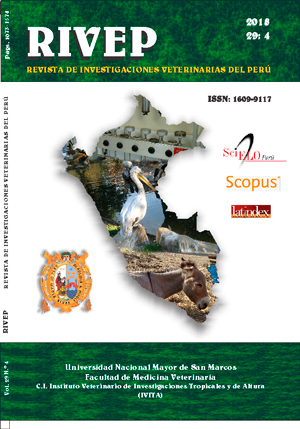Generation of a protocol for the synthesis of chitosan nanoparticles loaded with florfenicol through the ionic gelation method
DOI:
https://doi.org/10.15381/rivep.v29i4.15203Keywords:
antibiotics, drug release, polymer, nanomaterialsAbstract
The formation of nanoparticles of chitosan by the ionic gelation method has a high potential for loading, transport and controlled release of molecules. It is a simple method and the nanoparticles have good absorption, stability, biocompatibility and low toxicity. Florfenicol is one of the most used antibiotics in the aquaculture industry and is administered mixed with the feed in high concentrations, which generates problems of effective doses and unwanted residues. In this way, the synthesis of chitosan (Q) nanoparticles loaded with florfenicol could provide advantages when it comes to protecting, transporting and releasing the drug in fish of economic interest in a controlled manner. In the present study, nanoparticles of chitosan and sodium tripolyphosphate (TPP) with and without florfenicol were synthesized to evaluate their effective loading and release. The results obtained with FTIR spectrometry corroborate the formation of the Q-TPP nanoparticles with the changes observed in the infrared spectra patterns between the matrix chitosan and the synthesized nanoparticles. Q-TPP nanoparticles can carry between 48 and 50% of florfenicol inside. The in vitro release assay of the antibiotic showed a controlled and stable release over time under conditions of acid pH and controlled temperature of 15 °C for up to 10 days. Finally, it is shown that the Q-TPP nanoparticles have the potential to trap and release the evaluated drug in a controlled manner.Downloads
Downloads
Published
Issue
Section
License
Copyright (c) 2018 Erico R. Carmona, Tania Plaza, Gonzalo Recio-Sánchez, Jorge Parodi

This work is licensed under a Creative Commons Attribution-NonCommercial-ShareAlike 4.0 International License.
AUTHORS RETAIN THEIR RIGHTS:
a. Authors retain their trade mark rights and patent, and also on any process or procedure described in the article.
b. Authors retain their right to share, copy, distribute, perform and publicly communicate their article (eg, to place their article in an institutional repository or publish it in a book), with an acknowledgment of its initial publication in the Revista de Investigaciones Veterinarias del Perú (RIVEP).
c. Authors retain theirs right to make a subsequent publication of their work, to use the article or any part thereof (eg a compilation of his papers, lecture notes, thesis, or a book), always indicating the source of publication (the originator of the work, journal, volume, number and date).










